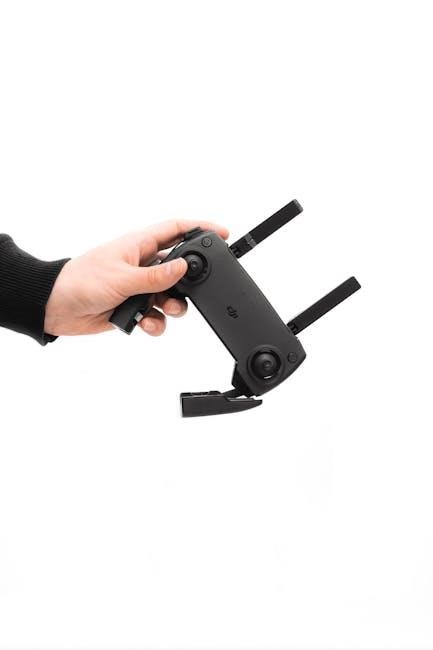The Silent Knight 5207 User Manual provides comprehensive guidance for installing, programming, and operating the Model 5207 Fire Control/Communicator. It covers system features, setup, and troubleshooting.
1.1 Overview of the Silent Knight 5207 Fire Control/Communicator
The Silent Knight 5207 is a fire control/communicator designed for commercial and industrial fire alarm systems. It features an 8-zone expandable system, digital communicator, and built-in touchpad for easy operation. This panel is ideal for monitoring fire safety in large facilities, ensuring reliable detection and alert systems. With its robust design and compliance with safety standards, the Model 5207 is a comprehensive solution for fire protection needs.
1.2 Key Features of the Model 5207
The Model 5207 features an 8-zone fire control/communicator with expandable capacity up to 16 zones. It includes a built-in touchpad for user-friendly operation and a digital communicator for reliable alarm transmission. The panel supports Class B (Style A) circuits and offers programmable signal circuits for versatility. Its fuseless design enhances reliability and simplifies maintenance. The system is compatible with a range of detectors and modules, ensuring comprehensive fire safety coverage. With advanced diagnostics and compliance with industry standards, the Model 5207 is a robust solution for commercial and industrial fire alarm systems.
1.3 Intended Use and Applications
The Silent Knight 5207 Fire Control/Communicator is designed for use in commercial and industrial fire alarm systems. It is suitable for monitoring multiple zones and signal circuits, ensuring reliable fire detection and notification. The system is ideal for large facilities, such as office buildings, warehouses, and public spaces, where comprehensive fire safety is critical. Its expandable design supports up to 16 zones, making it versatile for various applications. The Model 5207 is intended to provide early detection and communication of fire events, ensuring timely response and safety. It is compatible with a range of smoke and heat detectors, offering robust fire protection solutions.

Installation Guidelines
The Silent Knight 5207 installation requires careful pre-installation planning, proper panel mounting, precise wiring, and optional module setup. Follow all safety and fire code standards.
2.1 Pre-Installation Requirements and Considerations
Before installing the Silent Knight 5207, ensure compatibility with local fire codes and regulations. Verify the system’s power requirements and environmental conditions. Familiarize yourself with the panel’s components, including the built-in touchpad and digital communicator. Check compatibility with optional modules like the 3158 Keltron Module. Prepare all necessary tools and documentation. Ensure proper grounding and wiring practices. Validate the system’s expandability to 16 zones if needed. Review the installation manual thoroughly to avoid errors. Confirm the panel’s placement adheres to accessibility standards. Plan for future system upgrades and maintenance. Ensure all personnel involved are trained in fire alarm installation best practices.
2.2 Mounting the Model 5207 Panel
Mount the Silent Knight 5207 panel in a location that is easily accessible for operation and maintenance. Ensure the area is free from environmental hazards and extremes in temperature or humidity. Use a sturdy backbox to secure the panel, following the manufacturer’s recommendations. Align the panel properly and use the provided screws to fasten it securely. Ensure the panel is level to maintain proper functionality. Avoid mounting in areas with high vibration or exposure to water. Verify that all wiring connections are accessible and protected. After mounting, test the panel’s connectivity and power supply to ensure proper operation. Follow local fire safety codes for placement.
2.3 Wiring the Fire Control/Communicator
When wiring the Model 5207, ensure all connections are secure and meet local fire safety codes. Connect zone circuits to the appropriate terminals, ensuring proper polarity. The power supply should be connected to the designated terminals, with a backup battery installed as specified. Communication lines for the digital communicator must be wired correctly, following the manufacturer’s guidelines. Use the correct gauge wire for all connections to prevent signal loss or interference. Double-check all wiring before powering on the system. Refer to the wiring diagram in the manual for specific terminal assignments and connections. Proper wiring is essential for reliable system operation and compliance with safety standards.

2.4 Installing Optional Modules and Accessories
Optional modules and accessories for the Model 5207 can enhance system functionality. Installation requires powering down the panel first. Use a screwdriver to remove the chassis cover and access the module slots. Insert the module firmly into its slot, ensuring proper alignment. Secure it with screws and reconnect the cover. For accessories like keypads or remote annunciators, follow the wiring diagram in the manual. Ensure all connections are tight and compatible with the system. After installation, power up the panel and test the new components to confirm proper operation. Refer to the manual for specific module compatibility and installation instructions.

Programming the Silent Knight 5207
Programming the Model 5207 involves configuring zones, signal circuits, and the digital communicator. The built-in touchpad simplifies setup, while system testing ensures proper post-installation functionality and reliability.

3.1 Configuring Zones and Signal Circuits
Configuring zones and signal circuits on the Silent Knight 5207 involves defining the system’s detection and notification parameters. Zones can be set up to monitor specific areas, while signal circuits control outputs like alarms or notifications. The Model 5207 supports up to 8 zones and 4 signal circuits, expandable to 16 zones with optional modules. Each zone can be programmed for different sensitivity levels or response types, such as smoke or heat detection. Signal circuits are configured to trigger specific responses, such as activating horns or strobes. Proper configuration ensures the system operates efficiently, providing reliable fire detection and alarm responses in various scenarios.
3.2 Setting Up the Digital Communicator
Setting up the digital communicator on the Silent Knight 5207 ensures reliable communication between the fire control panel and monitoring stations. The communicator supports various transmission formats, including DACT (Digital Alarm Communicator Transmitter) and internet-based protocols. Configuration involves entering account information, selecting communication paths, and enabling encryption for secure data transmission. The communicator can also be programmed to send alerts to multiple recipients, providing real-time updates during emergencies. Proper setup requires adherence to local regulations and compatibility with the monitoring service provider. Once configured, the system performs regular tests to ensure uninterrupted communication, enhancing overall system reliability and emergency response capabilities.
3.3 Programming the Built-in Touchpad
Programming the built-in touchpad on the Silent Knight 5207 involves configuring user permissions, zone assignments, and custom functions. Access the touchpad menu by entering the system’s passcode, then navigate to the programming section. Define zones and signal circuits, ensuring each zone corresponds to its designated area. Set up user codes for authorized personnel and enable features like silent alarms or delayed arming. The touchpad also allows customization of display messages and troubleshooting codes. After programming, test all functions to ensure proper operation. Detailed step-by-step instructions are provided in the manual to guide users through the process effectively.
3.4 Testing the System Post-Installation
After installation, the Silent Knight 5207 must undergo thorough testing to ensure all components function correctly. Test each zone by triggering a smoke or heat detector to verify proper alarm activation. Check signal circuits to confirm they communicate alerts to the monitoring station. Test the digital communicator by sending a test signal and confirming receipt. Verify that all optional modules and accessories integrate seamlessly with the system. Perform a walk-test to ensure zone wiring and device connectivity are intact. Review the system’s event log to ensure no errors or issues are present. Correct any issues before finalizing the installation.

Operating the Model 5207
The Model 5207 offers intuitive operation via its built-in touchpad, enabling easy monitoring, control, and interaction with the system. Users can manage zones, respond to alarms, and perform routine checks efficiently.
4.1 Basic Operation of the Built-in Touchpad
The built-in touchpad on the Model 5207 provides a user-friendly interface for system interaction. Users can navigate through menus to monitor zones, silence alarms, and perform basic functions. The touchpad displays status messages, ensuring clear communication of system conditions. By following on-screen prompts, operators can easily access system settings and execute commands. The touchpad’s intuitive design allows for quick response during emergencies, ensuring efficient management of fire safety operations. Regular use of the touchpad helps maintain system readiness and user familiarity, making it an essential tool for daily operations and critical situations.
4.2 Understanding Display Messages and Codes
The Model 5207’s display provides critical system status updates through messages and codes. These notifications indicate normal operation, alarms, or faults. For example, zone-specific issues or communication errors are highlighted. Users can quickly identify system conditions by recognizing standard symbols and abbreviations. Regular review of display messages ensures proactive system management. The manual includes a reference guide for decoding these messages, enabling users to address issues promptly. Understanding these codes is essential for maintaining system reliability and responding effectively during emergencies or malfunctions. Familiarity with the display messages enhances overall system performance and user confidence in managing fire safety operations.
4.3 Performing Routine System Checks
Routine system checks are vital to ensure the Model 5207 operates reliably. Users should test all zones, signal circuits, and communication links regularly. The manual outlines step-by-step procedures for these checks, including verifying battery levels and ensuring all components are functioning correctly. It also recommends checking for any new error codes or messages on the display. Conducting these checks helps prevent unexpected system failures and ensures compliance with fire safety regulations. Regular maintenance not only prolongs system lifespan but also guarantees optimal performance during emergencies. By following the manual’s guidelines, users can maintain a robust and dependable fire safety system;
4.4 Responding to Alarms and Troubleshooting Common Issues
When an alarm occurs, users should immediately silence the system using the touchpad and investigate the cause. The manual provides clear steps for responding to alarms, including identifying zones or circuits triggering the alert. For troubleshooting, the guide outlines common issues like communication errors or zone malfunctions, offering solutions such as resetting the system or checking wiring connections. Error codes displayed on the touchpad help diagnose problems quickly. The manual also covers resetting the system to default settings if needed. Regular system checks and maintenance can prevent many issues, ensuring the Model 5207 remains reliable and effective in emergency situations.

Technical Specifications
The Silent Knight 5207 features 8 zones, expandable to 16, with 4 signal circuits and a built-in digital communicator. It supports optional modules for enhanced functionality.
5.1 Hardware Specifications of the Model 5207
The Model 5207 Fire Control/Communicator is equipped with an 8-zone capacity, expandable to 16 zones, and 4 signal circuits. It features a built-in digital communicator, a fuseless design, and a touchpad interface for user interaction. The panel supports optional modules, such as the 3158 Keltron Module, to enhance system functionality. Its hardware includes a robust processor and memory to handle advanced fire alarm and communication tasks efficiently. The unit is designed for reliability, with components that ensure long operational life under various environmental conditions. These specifications make it suitable for both small and large-scale fire safety installations.
5.2 Environmental and Operating Conditions
The Silent Knight 5207 operates effectively in temperatures ranging from 32°F to 120°F (0°C to 49°C) and humidity levels up to 93% RH non-condensing. It is designed to function in non-corrosive environments and requires a nominal 24 VDC power supply. The system is suitable for installation in commercial and residential settings, supporting up to 16 zones and 4 signal circuits. Its robust design ensures reliability in various operating conditions, making it ideal for fire safety installations requiring consistent performance. Proper ventilation and adherence to installation guidelines are essential to maintain optimal functionality and longevity of the system.
5.3 Compliance and Certifications
The Silent Knight 5207 Fire Control/Communicator meets rigorous industry standards, including UL 864 10th Edition and NFPA 72 requirements. It is certified for use in commercial fire alarm systems, ensuring reliability and compliance with safety regulations. The system adheres to UL 985 standards for household fire warning systems and is FM-approved for performance in hazardous locations. Compliance with these certifications ensures the Model 5207 delivers dependable fire detection and communication, meeting the needs of various applications. Its certifications underscore its suitability for installation in diverse settings, providing users with confidence in its performance and reliability.

Maintenance and Upkeep
Regular maintenance ensures optimal performance. Check sensors, clean components, and test systems monthly. Replace batteries annually and update software as required to maintain reliability and functionality.
6.1 Routine Maintenance Procedures
Regular maintenance is essential for the Silent Knight 5207 system. Inspect all sensors, clean smoke and heat detectors to prevent dust buildup, and test zone functionality monthly. Check the battery voltage and ensure the system logs no errors. Verify that all communication channels are active and functioning correctly. Perform a full system test quarterly, simulating various scenarios to ensure all components respond appropriately. Additionally, review and update system software periodically to incorporate the latest features and security patches. Proper documentation of maintenance activities is recommended to track system health and ensure compliance with safety standards. Regular upkeep ensures reliable operation and extends system lifespan.
6.2 Replacing Batteries and Other Components
Replace the Silent Knight 5207 batteries annually or when the system indicates low voltage. Use compatible, high-quality batteries to ensure reliable operation. Turn off the system before starting any replacement. For other components, such as sensors or communication modules, refer to the manufacturer’s specifications for compatibility. Replace faulty or outdated parts promptly to maintain system performance. Always disconnect power before performing any replacements. Dispose of old batteries and components responsibly. After replacement, test the system to ensure all functions operate correctly. If unsure, consult a qualified technician for assistance. Regular component replacement helps prevent system failures and ensures continuous fire protection. Proper tools are essential for safe and effective replacements.
6;3 Updating Software and Firmware
To update the Silent Knight 5207’s software and firmware, start by visiting the manufacturer’s website to check for the latest versions. Download the updates to your computer, ensuring they are compatible with your system. Connect your computer to the panel using the appropriate interface, such as USB, and use the provided tool to upload the new software and firmware. Avoid interrupting the power supply during the update to prevent system issues. After installation, verify the version numbers to confirm success. Backup your settings beforehand to avoid data loss. Check for any compatibility issues with connected devices and review release notes for specific instructions. Test the system thoroughly post-update to ensure all components function correctly. If issues arise, consult the manual or contact technical support for assistance.

Troubleshooting Common Issues
This section addresses common issues, such as alarm troubleshooting, wiring checks, and power supply verification. It provides step-by-step solutions and diagnostic tools to resolve system malfunctions efficiently.
7.1 Diagnosing and Resolving Communication Errors
Communication errors in the Silent Knight 5207 can be diagnosed by checking the touchpad display for specific error codes. Verify wiring connections and ensure the digital communicator is properly configured. Test signal strength and confirm network settings. Reset the system if necessary and update firmware to resolve issues. Ensure all components are compatible and functioning correctly. Refer to the troubleshooting guide for detailed step-by-step solutions to restore communication efficiently.
7.2 Addressing Zone and Circuit Malfunctions
Zones and circuits on the Silent Knight 5207 may malfunction due to wiring issues, faulty devices, or incorrect configurations. Check the touchpad display for specific error codes indicating zone or circuit problems. Inspect wiring for damage or loose connections and verify device compatibility. Test each zone individually to isolate the issue. Reset the system or recalibrate zones if necessary. Replace faulty devices or components as required. Ensure all zones are properly configured and aligned with the system’s programming. Refer to the troubleshooting guide for detailed instructions on resolving zone-related issues and restoring system functionality effectively.
7.3 Resetting the System and Restoring Default Settings
Resetting the Silent Knight 5207 system restores it to factory defaults, erasing all custom configurations. This should only be done by authorized personnel. To reset, access the touchpad menu, navigate to “System Settings,” and enter the administrator code. Select “Reset to Defaults” and confirm. The system will reboot, reverting all settings to their original state. Note that this process will clear all programmed zones, signal circuits, and communicator settings. After resetting, reprogram the system according to your specific requirements. Ensure all devices are reconnected and tested to maintain proper functionality. Refer to the manual for detailed reset procedures and precautions.

Appendices
The appendices provide a glossary of terms, contact information for support, and warranty details, serving as an essential reference guide for users.
8.1 Glossary of Terms
This section provides definitions for key terms and concepts related to the Silent Knight 5207 Fire Control/Communicator. It includes explanations of technical terms like “zone,” “signal circuit,” “communicator,” and “touchpad” to ensure clarity. Additional terms such as “alarm condition,” “trouble condition,” and “system reset” are defined to help users understand system operations. The glossary also covers advanced features like “digital communicator” and “expandable zones” for comprehensive understanding. This reference guide is essential for users to interpret messages, troubleshoot issues, and maintain the system effectively.
8.2 Contact Information for Support
For technical assistance, training, or general inquiries, contact Silent Knight support at support@silentknight.com or call [phone number]. Visit their official website at https://www.silentknight.com for resources, manuals, and updates. For urgent issues, reach out to their 24/7 support hotline at [hotline number]. Mailing address: Silent Knight, [physical address]. Ensure to have your system model and serial number ready for efficient assistance. This section provides all necessary contact details to connect with Silent Knight’s professional support team.
8.3 Warranty and Service Information
The Silent Knight 5207 Fire Control/Communicator is backed by a limited warranty covering manufacturing defects for a specified period. For warranty details, visit https://www.silentknight.com or contact customer support. Warranty claims require proof of purchase and may exclude damage from misuse or unauthorized modifications. Extended service plans are available for additional coverage. Register your product online to ensure warranty validity. For service requests, contact Silent Knight’s authorized distributors or certified technicians. Warranty terms vary by region, so review the provided documentation or consult with support for specific conditions and procedures.


